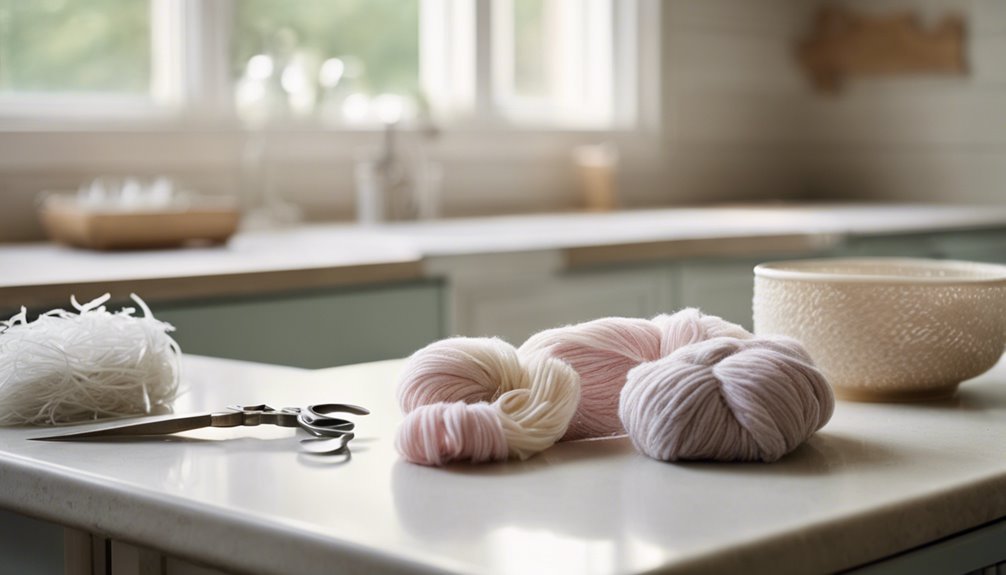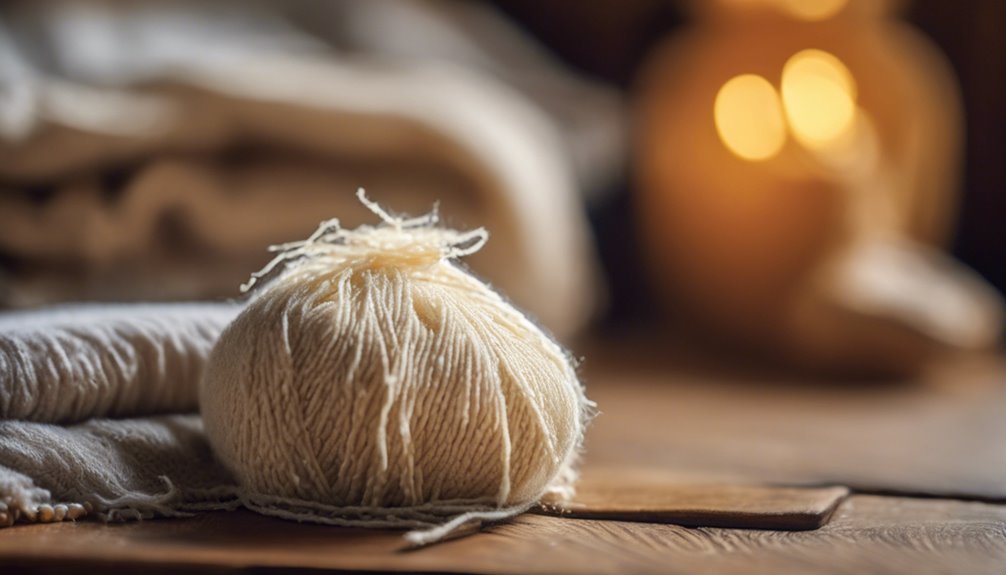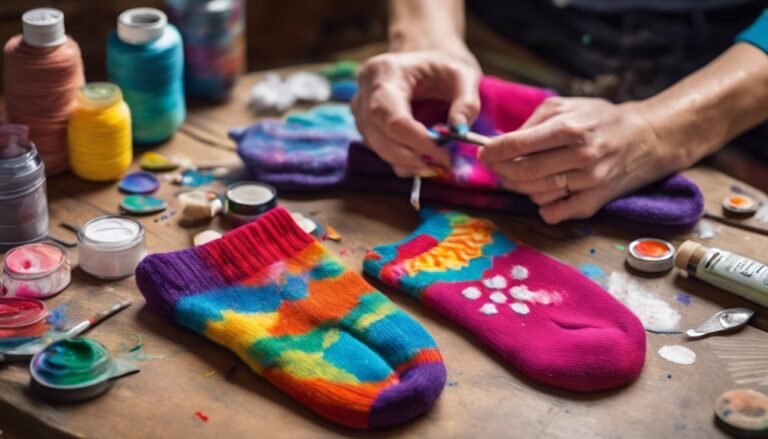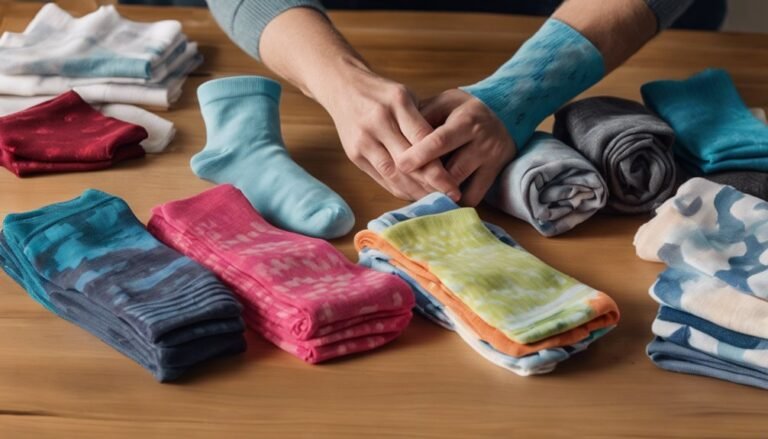How to Make a Heating Pad With Rice and Socks
To make a heating pad with rice and socks, gather an uncooked rice, a cotton sock, and a microwave or oven. Fill the sock with 1 to 3 cups of rice, depending on the sock size, and secure the opening with a knot or sewing. Heat it for 1-3 minutes, test the temperature, and apply it to sore areas for relief. For more creative ideas and maintenance tips, keep exploring!
Gather Your Materials

Before you immerse yourself in making your heating pad, you'll want to gather all the necessary materials to guarantee a smooth process. Start with some uncooked rice, as it offers excellent heat retention, making it one of the best options for your heating pad. Consider the rice benefits: it's non-toxic, reusable, and easy to heat. Next, you'll need a sock—this is where your choice of sock types comes into play. Opt for a thick, sturdy sock to hold the rice effectively. Avoid any that have holes or thin fabric, as they'll likely burst during use. Finally, make sure you have a microwave or oven ready for heating. With these materials, you're set to create a functional and comforting heating pad.
Choose the Right Sock
Selecting the right sock is essential for the effectiveness of your heating pad. First, consider sock materials. Cotton is a great choice because it's breathable and holds heat well, while wool can provide added warmth. Avoid synthetic materials, as they may not withstand microwaving and could release harmful chemicals.
Next, think about sock sizes. A larger sock allows for more rice and can cover a bigger area, which is helpful for larger muscle groups. However, if you're targeting smaller areas, a standard-sized sock will work just fine. Ultimately, choose a sock that fits your comfort needs and heating pad purpose. With the right sock, you'll enjoy a soothing, homemade heating pad that helps you relax and feel better.
Measure the Rice
When it comes to your heating pad, the type of rice you choose matters. You'll need to determine how much rice you'll require for your sock, so measure it accurately to guarantee even heating. Let's break down the options and quantities to get it just right.
Choose Rice Type
Choosing the right type of rice is essential for making an effective heating pad. Different rice types have unique properties that can enhance your experience. Here are three popular options:
- Brown rice: Known for its nutty flavor and moisture retention, it provides longer heat release.
- Jasmine rice: This fragrant rice heats quickly and can give a soothing aroma while warming.
- White rice: It's a common choice, but it may not retain heat as long as brown or jasmine.
Consider what you value most in your heating pad. Whether it's the aroma, heat retention, or quick heating, your choice of rice will impact your comfort. Test different types to find the one that suits your needs best!
Determine Quantity Needed
After you've picked the right type of rice for your heating pad, the next step is figuring out how much you'll need. The rice quantity you choose depends on the sock size you're using. For standard crew socks, about 1 to 2 cups of rice should do the trick. If you're using larger socks, you might want to increase that amount to 3 cups or more. Remember, the goal is to fill the sock enough so it can contour to your body but not so full that it becomes stiff. This way, you'll get the comfort you need without sacrificing flexibility. So, think about your sock size and adjust the rice quantity accordingly for the best results.
Measure Accurately
Measuring the rice accurately is essential for creating an effective heating pad. If you want the right balance of warmth and flexibility, you need to use proper measuring techniques and devices. Here are a few tips to help you get it right:
- Use a standard measuring cup for precise amounts.
- Weigh the rice on a kitchen scale for accuracy.
- Avoid overpacking the sock to guarantee it can bend and shape comfortably.
Fill the Sock

Filling the sock is a straightforward yet essential step in creating your heating pad. You'll want to choose the filling carefully, whether you stick to rice or explore rice alternatives like flaxseed or dried beans. Here are some effective filling techniques to evaluate:
| Filling Technique | Description |
|---|---|
| Scoop and Pour | Use a funnel for easy filling. |
| Pinch and Shake | Shake gently to distribute evenly. |
| Layering | Alternate between fillings for texture. |
| Measuring | Use a scale for precise amounts. |
Aim for a snug fit without overstuffing. A well-filled sock will hold heat evenly, providing you with soothing relief when you need it. Enjoy the freedom to customize your heating pad to suit your needs!
Secure the Opening
Now that you've filled the sock, it's time to secure the opening to keep everything in place. You can tie a knot, use fabric glue, or sew it closed securely—whichever method you prefer. Just make sure it's tight enough to prevent any filling from spilling out.
Tie a Knot
To secure the opening of your heating pad, tie a tight knot with the fabric. This step is vital to keep the rice from spilling out during use. You can use various knot techniques, but here are three effective methods for knot tying:
- Square Knot: Simple and reliable, perfect for beginners.
- Bowline Knot: Creates a fixed loop, ensuring a secure closure.
- Double Knot: Adds extra security, preventing accidental loosening.
Whichever technique you choose, make sure it's snug. You want your heating pad to be functional and safe, so a well-tied knot is necessary. Enjoy the cozy warmth without worrying about your rice escaping! Embrace the freedom of DIY with your homemade heating pad.
Use Fabric Glue
If tying a knot isn't your preferred method for securing the opening of your heating pad, fabric glue offers a reliable alternative. This approach works well with various fabric types, allowing you to customize your heating pad to suit your style. Simply apply a generous amount of fabric glue along the edges of the opening, making certain it's evenly spread. Press the edges together and hold them until the glue sets.
If you're looking for glue alternatives, consider options like hot glue or even fusible fabric tape for a quick and effective seal. Just make sure whatever adhesive you choose is suitable for the fabric types you're using. This method keeps your rice securely inside while allowing for a clean, polished finish.
Sew Closed Securely
Once you've filled your heating pad with rice, securing the opening by sewing it closed is a sturdy option that guarantees your filling stays in place. To verify a secure and safe finish, consider these safety precautions and effective sewing techniques:
- Use a strong thread that can withstand heat.
- Make small, tight stitches to prevent any rice from escaping.
- Double knot your thread at the end for extra security.
Heat Your Pad
As you prepare to heat your pad, it's important to choose the right method to guarantee it warms up safely and effectively. The two most common heating methods are the microwave and the oven. Microwaving is quick and convenient, allowing you to enjoy the rice benefits, such as soothing sore muscles, in just a few minutes. If you opt for the oven, set it to a low temperature and place your pad inside for a more gradual heat distribution. Whichever method you choose, make sure that you monitor the time closely to prevent overheating. With the right approach, your homemade heating pad will provide comforting warmth, enhancing relaxation and relief when you need it most. Enjoy your freedom to create a personalized remedy!
Test the Temperature

After heating your pad, it's important to verify it's at a safe temperature before use. You don't want to risk burns or discomfort. Here are a few simple testing methods to ascertain temperature safety:
- Wrist Test: Place the pad against your wrist for a few seconds. If it feels too hot, it needs more cooling time.
- Knee Test: Gently rest the pad on your knee. Your knee is sensitive, making it an excellent gauge for safe temperature.
- Layer Check: If you're unsure, wrap the pad in a thin towel. This adds a layer of protection and can help moderate the heat.
Always prioritize your safety and comfort when using your homemade heating pad!
Apply the Heating Pad
When you're ready to apply the heating pad, make sure you find a comfortable position where you can relax. You can place it directly on the area that needs relief, whether it's your back, neck, or abdomen. The rice inside the sock will provide gentle, soothing heat that can help ease tension and discomfort. Be mindful not to apply heating for too long—typically, 15 to 20 minutes is ideal. This allows you to enjoy the comfort benefits without risking overheating. If you feel the heat becoming too intense, remove the pad immediately. Listen to your body, and adjust accordingly. With this simple approach, you'll experience the soothing warmth that can enhance your relaxation. Enjoy your newfound comfort!
Care and Maintenance
To keep your heating pad in great shape, regular cleaning is essential. You'll also want to store it properly to guarantee it lasts longer. Let's go over some simple care and maintenance tips.
Cleaning the Heating Pad
Keeping your heating pad clean is essential for both hygiene and longevity. To guarantee your pad stays fresh and functional, consider these cleaning methods and their recommended cleaning frequency:
- Spot clean any spills or stains immediately with a damp cloth.
- Wash the sock cover every 1-2 weeks to prevent odor and dirt buildup.
- Replace the rice inside every few months to keep it fresh and effective.
Storing for Longevity
After ensuring your heating pad is clean, proper storage also plays a significant role in maintaining its functionality and lifespan. Here are some storage tips and longevity strategies to keep your rice-filled heating pad in great shape:
| Storage Method | Benefits | Tips |
|---|---|---|
| Cool, Dry Place | Prevents moisture damage | Avoid damp areas |
| Loose Bag | Allows air circulation | Don't pack tightly |
| Away from Heat | Maintains rice integrity | Keep away from heaters |
| Regular Checks | Detects wear or damage early | Inspect every few months |
Creative Variations
There are plenty of creative variations you can try when making a heating pad that not only enhance its functionality but also add a personal touch. Consider these options:
- Aromatic herbs: Add dried lavender or chamomile to your rice for soothing scents.
- Colored rice: Use dyed rice for a fun, vibrant look that matches your decor.
- Essential oils: Mix a few drops of your favorite essential oil into the rice for an aromatic experience.
These variations not only make your heating pad more enjoyable but also allow you to customize it to your preferences. Whether you want relaxation or a pop of color, these ideas give you the freedom to create a unique heating pad that meets your needs. Enjoy your cozy, personalized comfort!
Frequently Asked Questions
Can I Use Other Grains Instead of Rice?
You've got options! Quinoa benefits include being lightweight and filled with nutrients, while barley alternatives offer a sturdy choice. Experimenting with different grains can make your heating pad experience even more enjoyable and versatile.
How Long Does the Heating Pad Last Before Needing to Be Reheated?
The heating pad's duration depends on factors like microwave power and grain type, typically lasting 15 to 30 minutes. You'll need to reheat it frequently to maintain warmth, giving you consistent comfort whenever needed.
Is It Safe to Microwave the Heating Pad Multiple Times?
You'd think microwaving a heating pad endlessly is a great idea, but it's not. For microwave safety, limit reheating to preserve the heating pad's durability. Overuse could lead to leaks or burns—definitely not what you want!
Can I Add Essential Oils for a Pleasant Scent?
Absolutely, you can add essential oils for a pleasant scent. Just a few drops will enhance your heating pad's aroma. Consider scent options like lavender or eucalyptus for a soothing experience while you relax.
What if My Heating Pad Smells Burnt?
If your heating pad smells burnt, it could be due to overheating or using too much rice. To prevent burnt odor, always heat in short intervals and guarantee proper ventilation before using it again.







